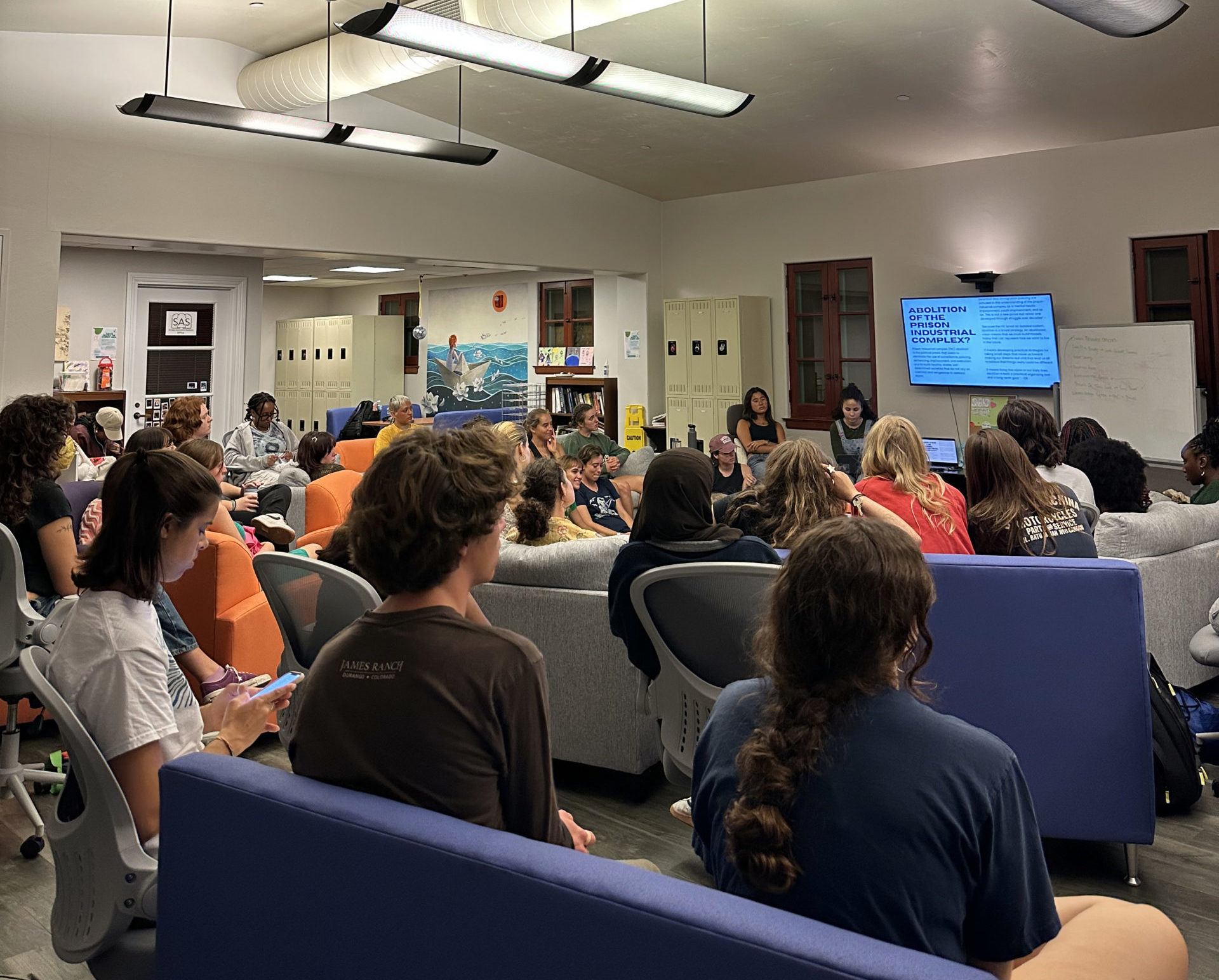
October 6, 2023
"There's a level of community that [is needed] in order for carceral options to not be the primary response from people when they're facing some sort of inconvenience."

More than 40 students attended 5C Prison Abolition Collective (PrisAb)’s first teach-in of the academic year, “Intro to Policing and the Prison Industrial Complex (PIC)”, at Scripps Student Union on Monday evening. Jane Lovett SC’25, Blessing Roland-Magaji SC’24, Cassie Bensko SC’25, Jacqueline Tsai SC’25, Kaliyah Keita PO’25 led the presentation. The meeting aimed to educate students on the current policing and prison industry complex in the US, and how this knowledge can inform the 5C community’s perspective on Campus Security.
Policing in the U.S
Before delving into details about the PIC, Bensko introduced the concept of policing and how policing is connected to the oppression of marginalized groups in America. In doing so, Bensko contended that policing has its origins in slavery and Black Codes, serving as a means to enforce social control over marginalized communities.
“Police forces have been used to keep new immigrants ‘in line’ and to prevent the poor and working classes from making demands”, Bensko said.
After providing an overview of policing, Bensko went on to highlight that as social conditions evolve, the way policing targets marginalized individuals also shifts. Following this, Tsai took the lead in discussing “soft policing,” a concept in which police power relies less on direct coercion and more on a persuasive form of social control.
Tsai proceeded to emphasize the significance of recognizing these less visible forms of policing, by referencing Mariame Kaba and Andrea Ritchie’s book, No More Police: A Case for Abolition:
“When our organizing exclusively targets the overt violence of law enforcement, it may hinder us from identifying and addressing the subtle ways in which policing principles are woven into social policies and concealed within the daily operations of the state.”
In an interview with Undercurrents, Keita expressed that educating folks on the logic of policing is intended to urge them to reconsider the role of 5C Campus Security, which has ties to the Claremont Police Department. By scrutinizing the perception of Campus Security as peacekeepers on campus, 5C community members can strive to center the safety and well-being of one another without involving “external institutions that don’t have our best interest at heart.”
“There’s a level of community that [is needed] in order for carceral options to not be the primary response from people when they’re facing some sort of inconvenience.”
Kaliyah Keita PO ’25
“There’s a level of community that [is needed] in order for carceral options to not be the primary response from people when they’re facing some sort of inconvenience. [For example, when] your roommate or someone in your hall is making a bunch of noise, there’s a way that you could knock on their door and say something rather than calling the police.”
The Prison Industrial Complex (PIC)
As Keita described, the PIC functions to empower and uphold individuals who derive their power from factors such as race, economic status, and other privileges.
This power is amassed and sustained through various ways within the PIC, including the creation of mass media portrayals that perpetuate stereotypes of marginalized groups, such as people of color, people in poverty, queer individuals, immigrants, youth, and other oppressed communities, portraying them as criminals, delinquents, or deviants.
This power is also perpetuated through the accumulation of huge profits for private companies involved in prisons and police forces. It also plays a role in securing political gains for “tough on crime” politicians; increasing the influence of prison guard and police unions; and suppressing social and political dissent by marginalized communities that advocate for self-determination and reorganization of power in the US.
Abolition of the PIC
Roland-Magaji moved on to introduce the concept of PIC abolition. According to her, PIC abolition is the political axis that seeks to eliminate the use of surveillance, policing, sentencing, imprisonment, and execution.
The goal of prison abolition is to foster the development of healthy, stable, self-determined societies that do not rely on coercion and vengeance as means to address harm.
Abolition calls for an end to a wide range of policing models, including detention and immigration policing, as well as mental health and youth imprisonment. Roland-Magaji quotes Critical Resistance to emphasize how abolition strives to create models in the present that can represent how we want to live in the future.
“An abolitionist vision means developing practical strategies for taking small steps that move us toward making our dreams real and that lead us all to believe that things really could be different.”
Blessing Roland-Magaji, SC’23
“Because the PIC is not an isolated system, abolition is a broad strategy. An abolitionist vision…means developing practical strategies for taking small steps that move us toward making our dreams real and that lead us all to believe that things really could be different.”
Abolitionist vs Reformist Reform
Lovett drew a clear distinction between the reformist and abolitionist approaches to the PIC. The reformist approach focuses on making minor “top-down” changes to the PIC that do not threaten its existence. These reforms often result in the expansion of the prison system itself, through the incorporation of technology and increased budgets, as exemplified by electronic-monitored house arrests.
Lovett underscored that reformist reforms may appear to address the harms of the PIC while, in reality, they serve to enlarge, intensify, and legitimize the carceral state. These reforms typically allocate more resources, including money and power, and lend greater legitimacy to the very system that PIC abolitionists aim to dismantle.
Body cameras for the police is one example of reform that was presented as measures to enhance police accountability and ensure public safety. However, in reality, they increase policing budgets to acquire additional gadgets, which further increase police surveillance
In contrast, the abolitionist approach seeks to completely dismantle the prison system and undo its entire existence for the benefit of the people it oppresses. This approach aims to address root cause issues and chip away at the power of the system.
An illustration of an abolitionist measure is suspending the use of paid administrative leave for police under investigation for murder and excessive use of force. This measure reduces funding toward and the scale of policing. It challenges the presumption that the police have the right to employ violence, and questions the notion that police violence enhances public safety.
To summarize the sentiment, Lovett quoted Ruby C. Tapia, co-editor of “Interrupted Lives: Experiences of Incarcerated Women in the United States” (2010).
“Reformers object to how the prison is administered. Abolitionists object to the prison’s very existence.”
Future plans of PrisAb
Going forward, PrisAb aims to get the 5C involved in the prison abolition movement through both political education and direct action. In an interview with Undercurrents, Keita stressed the importance of educating the 5C community about policing, considering that the United States boasts the world’s largest prison system, with LA County having the second-largest jailing system in the country.
“[We try to be] as involved as we can in supporting people who are affected by these systems, and doing whatever we can with the resources that we have, as people in the position of privilege at these renowned academic institutions… to contribute to this fight.”
Other than shaping the 5C’s perception of policing and Campus Security through political education, Prisab leaders also plan to get involved in prison abolition movements through direct action, according to PrisAb leader Lovett Lovett SC ‘25.
Lovett shared that PrisAb plans to get involved in the efforts of Californians United for a Responsible Budget (CURB) at CRC Norco, the California Rehabilitation Center located near Claremont. CURB, a state-wide prison abolitionist coalition, conducts outreach outside the CRC Norco parking lot every weekend, providing families visiting incarcerated individuals with resources to support their loved ones in prison.
PrisAb leaders foresee challenges with engaging 5C members in this campaign, given the risk associated with direct encounters with the police, who have previously threatened to arrest CURB members for setting up tables too close to the prison. They also find difficulty with organizing a growing number of members joining the club.
“We have a lot of new members this year, which is so great. But it is also a challenge to start organizing together when we’re all still learning about abolition. As you saw tonight, [during the meeting] there [were] a lot of difficult questions [from] people… And I think there’s a reason it’s called a struggle. That’s what we struggle together,” said Lovett.
“A lot of the time these systems of oppression are very difficult to explain. And I think that’s also an obstacle that we’ll have in discussions [or when we are] speaking to someone else… there are complicated [and] personal feelings that also come with it.”
Fiona Sanchez PO’27
Fiona Sanchez PO’27, a first-time meeting attendee, found similar difficulties in bringing out discussions regarding abolition. “A lot of the time these systems of oppression are very difficult to explain. And I think that’s also an obstacle that we’ll have in discussions [or when we are] speaking to someone else… there are complicated [and] personal feelings that also come with it.”
Regardless, Sanchez was impressed by the meeting’s turnout and the diversity among attendees. “I thought it was really amazing to see so many people being interested in the club, and also that it is just completely run by students…. I think it’s great that so many communities and marginalized people come together.”
Nhi Nguyen works for Undercurrents. She likes journalism because it allows her to work in bed.


Palestine

Palestine

Palestine

Undercurrents reports on labor, Palestine liberation, prison abolition and other community organizing at and around the Claremont Colleges.

Issue 1 / Spring 2023
Setting the Standard
How Pomona workers won a historic $25 minimum wage; a new union in Claremont; Tony Hoang on organizing
Read issue 1